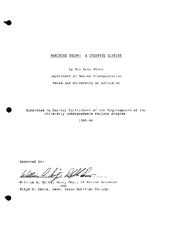| dc.description.abstract | As one surveys the coast of the Yucatan, even today, one of the most impressive sights is the Mayan ruins of Tulum. Compared to the great city of Seville by Spanish explorers, the town and its largest structure "EI Castillo" stand out from the shoreline and are visible from the sea for many miles. To what purpose was this structure dedicated by its builders, and what does its presence tell us about the civilization which erected it? In this paper, I will attempt to answer these questions based on a combination of historical research into the earliest Spanish accounts of the area, and upon a recent archeological expedition of which I was a member. I will propose a theory that this ruin represents a pre-Columbian lighthouse utilized in an active coastal trade in the last (Decadent) period of the Maya.
The organization of the paper is as follows. The first section gives a brief review of the history of the Maya from the Classic cultural period at Tikal and later at Chitzen Itza, to the so-called Decadent period more than a thousand years later characterized by a very powerful merchant class. It will be seen that this evolution coincided with a gradual movement of the active population centers towards the coast, and the development of a sophisticated trading society with important centers at Tulum and Cozumel. The second section contains a quite detailed discussion of the period of Spanish discovery of the Maya in which Tulum played an important part. From these accounts, it can be seen that the Maya, while not the equal of the Europeans in maritime skill, nevertheless had developed the ability to carryon long-distance sea trade and were active in it. The next section focuses on the area of Tulum and its historical and archeological position as a Mayaport. Finally we present our own findings from an expedition to Tulum during the summer of 1985. At that time, we performed a modern day simulation of a landing at Tulum using a canoe similar to those of the Maya. In addition, very detailed measurements both from land and at sea were made of the capabilities of the structures to act as navigational aids at night. (Considerable supporting details can be found in the appendicies.)
In the sections detailing the results of the expedition, I have made a number of comments from my own standpoint as a student majoring in marine transportation and looking at the archeological aspects from the point of view of an amateur. Thus, I have given some attention to the nature of the marine geography around Tulum including currents, winds, beaches, anchorages, obstacles and the barrier reef. These factors confront the mariner today as they did in the time of the Maya, and their evaluation forms an important part of this work. | en |


